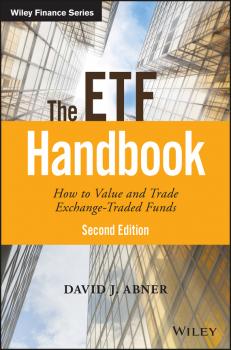ТОП просматриваемых книг сайта:
David Abner J.
Список книг автора David Abner J.Аннотация
A visual guide to one of the fastest growing areas in trading and speculation An Exchange-Traded Fund (ETF)—a security that tracks an index, a commodity, or a basket of assets like an index fund, but trades like a stock on an exchange—offers diversification of an index fund, as well as the ability to sell short, buy on margin, and purchase as little as one share. Giving financial advisors, institutional asset managers, traders, and other investment professionals the information they need to get the most out of ETF opportunities, the Bloomberg Visual Guide to ETFs covers the subject in a highly visual manner. Starting with an introduction to ETFs, the book looks at where they fit within the world of investment products, how they are structurally differentiated from other products and among themselves, relevant tax considerations, global listings, growth on a global basis, evolution of the product set, and other topics. Also looking towards the future, the text provides information on finding ETFs—including fund searches, fund news, measuring and valuing ETFs, evaluating their correlation to the underlying sector or commodity being tracked, and more. As a result, the book is a resource not just for understanding ETFs today, but for taking advantage of what's to come. Presents critical information in an easy-to-absorb visual manner Serves as a reference, presenting information in easily digestible pieces for easy access Author David Abner is a well-known ETF developer expert Incorporates quizzes, charts, and other accessible features to bring the material to life ETFs are multivarious, complex instruments that offer unique rewards, and the Bloomberg Visual Guide to ETFs brings together everything that people working with them need to understand to cash in.
Аннотация
Professional-level guidance on effectively trading ETFs in markets around the world The ETF Handbook is a comprehensive handbook for using Exchange Traded Funds, designed specifically for institutional investors and professional advisors seeking to improve ETF profitability. While ETFs trade like stocks, they are not stocks—and the differences impact every aspect of their use. This book provides full guidance toward effectively monitoring, analyzing, and executing ETFs, including the technical details you won't find anywhere else. You'll learn how they work, where they fit, and who is using them, as well as the resources that exist to provide access for investors. This new second edition includes updated coverage on how business has moved from niche to mainstream, ETF performance and issuers around the world, and changes to the users of ETFs in the US. The companion website features instructional video, as well as ready-to-use spreadsheets for calculating NAV and IIV. Most of the literature surrounding ETFs is geared toward individual investors or traders, but this book is written from the professional perspective—complete with the deeper mechanical information professionals require. Learn the analysis and execution methods specific to ETFs Discover why ETFs require a sophisticated level of skill Consider how ETFs perform in different market environments Examine the impact of managed ETF portfolio growth ETFs are incredibly flexible and valuable tools, but using them effectively demands a more sophisticated skillset, even among professional money managers and traders. Daily volumes and spreads do not tell the full story regarding availability and liquidity, and treating ETFs just like stocks can dramatically impact profits. The ETF Handbook is the professional's guide to the ETF markets worldwide with expert insight on the technical details that matter.


